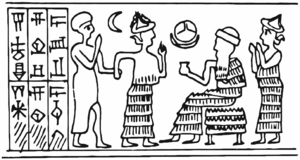Erishum I facts for kids
Quick facts for kids Erishum I |
|
|---|---|
| Išši’ak Aššur | |

This drawing shows a seal of Erishum I from Kültepe. The person sitting is likely the god Ashur. Erishum is the figure on the far left, being led towards him.
|
|
| King of Assur | |
| Reign | c. 1974–1935 BC |
| Predecessor | Ilu-shuma |
| Successor | Ikunum |
| Born | 20th century BCE |
| Died | 19th century BCE |
| Father | Ilu-shuma |
Erishum I (also spelled Erišu(m) I) was an important ruler of Assyria from about 1974 to 1935 BCE. He was the son of Ilu-shuma and the 33rd king listed on the Assyrian King List. Erishum I ruled for 40 years. During his time, he called himself "Išši’ak Aššur," which means "steward of Assur." This showed that the god Ashur was seen as the true king, and Erishum was his helper.
Erishum I's reign was a time when a new system was introduced: the limmu. A limmu was a person chosen each year to give their name to that year. This helped people keep track of time.
Contents
Erishum I's Reign: Building and Trade
Erishum I was a powerful king who helped Assyria grow. He focused on trade and building projects. His rule was a key period for the city of Assur.
Trade and Business Growth
During Erishum I's time, Assyrian merchants became very active. They set up trading posts far away in a region called Anatolia. These posts were known as karums. They were like special markets along trade routes.
Some important karums included Kanesh, Ankuwa, and Hattusa. There were also smaller "warbatums" that worked with the main karums. Merchants traded many goods, such as tin, textiles, lapis lazuli, iron, copper, and wool. In return, they received gold and silver.
About 23,000 clay tablets have been found at Kanesh. These tablets tell us a lot about trade during this period. They cover 129 years, starting from Erishum I's 30th year as king. These tablets even include copies of Erishum I's own writings.
Rules for Justice
Erishum I also made rules about how justice was handled in Assur. One important rule allowed people to have a rābiṣum, which was like an attorney, to speak for them in court.
One of Erishum I's inscriptions talks about these rules. It warns people not to lie in court. It says that if someone gives false information, bad things will happen to them. It also says that if someone follows the rules, they will get help from the palace and a fair decision from the judges.
Tax and Debt Relief
Following his father's example, Erishum I also announced tax exemptions. This meant that people didn't have to pay certain taxes. He also declared a "remission of debts." This meant that some debts, like those for silver, gold, copper, or grain, were forgiven. This helped many people in Assur.
Building Projects
Erishum I was also known for his many building projects. He built a temple for the god Assur, which he called "Wild Bull." This temple had a courtyard and special vats. He also built temples for the gods Ishtar and Adad.
Erishum I made the city of Assur stronger by enlarging its walls. He cleared an area from the Sheep Gate to the People's Gate to make space. He was proud to say that he built a wall "higher than the wall my father had constructed." Later kings, like Shamshi-Adad I and Shalmaneser I, remembered his building work. They noted how long it had been since Erishum I's walls were built.
Limmu Officials During Erishum I's Rule
The limmu was an important official chosen each year. Their name was used to identify that year. This system helped people keep track of time and events. Here are some of the limmu officials during Erishum I's reign:
- 1974 BC Šu-Ištar, son of Abila
- 1973 BC Šukutum, son of Išuhum
- 1972 BC Iddin-ilum, son of Kurub-Ištar
- 1971 BC Šu-Anim, son of Isalia
- 1970 BC Anah-ili, son of Kiki
- 1969 BC Suitaya, son of Ir'ibum
- 1968 BC Daya, son of Išuhum
- 1967 BC Ili-ellat
- 1966 BC Šamaš-t.ab
- 1965 BC Agusa
- 1964 BC Idnaya, son of Šudaya
- 1963 BC Quqadum, son of Buzu
- 1962 BC Puzur-Ištar, son of Bedaki
- 1961 BC Laqip, son of Bab-idi
- 1960 BC Šu-Laban, son of Kurub-Ištar
- 1959 BC Šu-Belum, son of Išuhum
- 1958 BC Nab-Suen, son of Šu-Ištar
- 1957 BC Hadaya, son of Elali
- 1956 BC Ennum-Aššur, son of Begaya
- 1955 BC Ikunum, son of Šudaya
- 1954 BC Is.mid-ili, son of Idida
- 1953 BC Buzutaya, son of Išuhum
- 1952 BC Šu-Ištar, son of Amaya
- 1951 BC Iddin-Aššur, son of the priest
- 1950 BC Puzur-Aššur, the ghee maker
- 1949 BC Quqadum, son of Buzu
- 1948 BC Ibni-Adad, son of Susaya
- 1947 BC Irišum, son of Adad-rabi
- 1946 BC Minanum, son of Begaya
- 1945 BC Iddin-Suen, son of Šalim-ahum
- 1944 BC Puzur-Aššur, son of Idnaya
- 1943 BC Šuli, son of Uphakum
- 1942 BC Laqip, son of Zukua
- 1941 BC Puzur-Ištar, son of Erisua
- 1940 BC Aguwa, son of Adad-rabi
- 1939 BC Šu-Suen, son of S.illia
- 1938 BC Ennum-Aššur, son of Begaya
- 1937 BC Enna-Suen, son of Pussanum
- 1936 BC Ennanum, son of Uphakum
- 1935 BC Buzi, son of Adad-rabi
See also
- Timeline of the Assyrian Empire
- Old Assyrian Empire
- List of Assyrian kings
- Assyrian continuity
- Assyrian people

